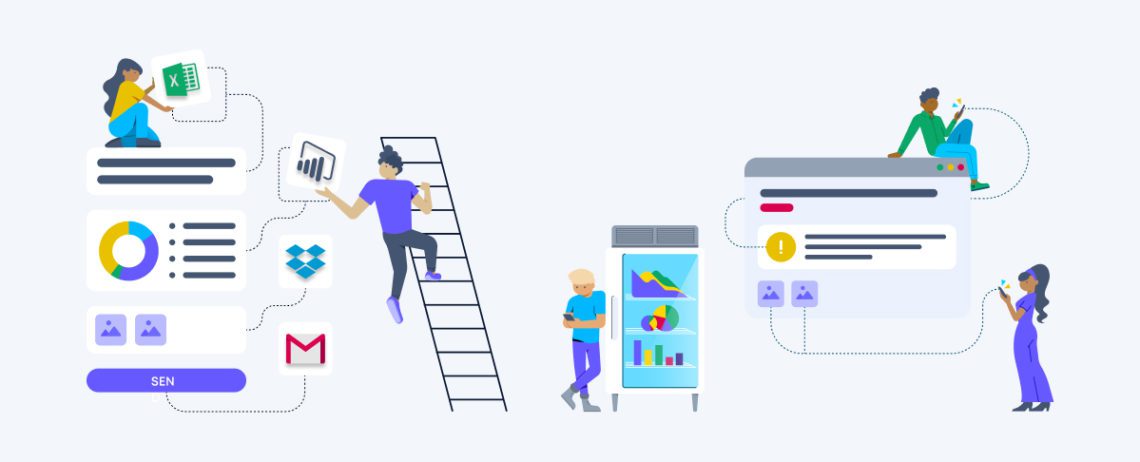The Future of Work: New Tech For Post-Pandemic Businesses
Ask The Experts | Feedback From The Field | Industry Trends | By | 26 Feb 2021 | 4 minute read


Rae Johnston, SafetyCulture guest contributor, multi-award-winning STEM Journalist, TV and Radio Presenter, and Host of technology podcast Queens of the Drone Age. The groundbreaking journalist explores new smart tools for businesses in a post-pandemic environment.
As the COVID-19 vaccine begins its rollout across the country – and the world – it’s tempting to imagine getting back to ‘business as usual’ sooner rather than later. The reality is, we will be living with the impacts of this pandemic well into the future.
“While vaccines offer much hope, the battle against the virus is not yet close to being won,” said Professor Sir Peter Gluckman, the President-elect of the International Science Council. “Different countries are in very different stages of the pandemic, the virus evolves, and access to vaccines and gaining effective lasting immunity will be a challenge in many countries.”
“Yet the virus knows no borders.”
Keeping everyone safe and well will continue to be a priority. Fortunately, technology can help.
It’s no secret that technology innovation and adoption has boomed in the last 12 months. According to Australian research firm AlphaBeta, businesses implemented as much technology in one year as they have in the previous ten – and this has come with many lessons we can take into the future.
Speaking with the Hear+Beyond Podcast, Dr Andrew Charlton points to the rapid growth taking businesses online wherever possible.
“This is an exciting trend, a real positive omen for the future,” said Charlton. “If there’s a silver lining to COVID, I think that massive technological change has been it.”
Working from home means a business can continue to operate while allowing social distancing. Technologies that enable secure access to data, virtual meetings, and even augmented reality have become the superstars of business lockdown.
But as businesses look to move to a more hybrid way of working – both online and in real life – the technology we’ve come to depend on in the last year is growing with them.
The Internet of Things
Take the billions of devices connected to the internet right now – all collecting and sharing data. The ways this network of information can benefit businesses will continue to be discovered.
The same tools that enabled remote work are now using this data to evolve into hybrid work essentials. Ceri Smith, who runs the SMB Sales Team for Zoom in Australia and New Zealand, spoke with SafetyCulture about the potential this creates.
“If it wasn’t for technology, and businesses being able to turn quickly and head home, I don’t think that we would be in the place that we are now,” said Smith.
Now that in-person meetings are becoming more common, we have more to consider before we sit down. Displays outside meeting rooms can show up-to-date safety protocols, and cameras counting the number of faces inside help us make the right call.
“As a meeting attendee, we can assess whether it’s safe and if we’re able to adhere to social distancing rules in that room before we even enter it.” said Smith.
It’s not just the people sensors are monitoring in these smaller, enclosed spaces. Air quality is a big concern – especially Co2, humidity, temperature, and volatile organic compound levels. We know how COVID thrives in particular environments. If a room gets too warm or too humid, or drops in temperature, we want to be able to see that in real-time.
Given the direction sensor technology is heading, the possibilities for automated thermal monitoring to be built-in into workplace tools are endless.
Safety Compliance
The role of supervision to ensure safety in the workplace has a newly-embraced technology assist. Sending automated hand-washing reminders to workers, recognising when they enter areas where masks are needed, and providing training information can all be done remotely.
Worker data can be collected and used to create analytics dashboards businesses can use to see compliance with safety checks in real-time. If there are any issues, they can be dealt with before they become a bigger problem. Managers can even send an immediate alert to a frontline worker with instructions on safely resolving the situation.
In the advancing world of technology, adapting to hybrid work environments means embracing paperless receipts, a simple yet profoundly impactful approach towards sustainability and efficiency. By integrating digital receipt management systems, businesses not only comply with safety but also enhance customer experience by offering hassle-free transactions. As we navigate through changes in workplace dynamics, considering environmental friendliness alongside the convenience of digital solutions propels us towards a greener future.
SafetyCulture Founder and CEO Luke Anear is confident that agility and immediacy is key to better managing risk in the workplace. “We’re experiencing the biggest workplace shake-up since economies were rebuilt after World War II. This is not survival of the fittest, this is survival of those that can adapt.”
This adaptability also applies to things like estimating and invoicing, with even smaller operators needing to evolve or risk being left behind. Using a handyman app to quote and bill clients is a good example of this, and ties in with safety compliance as a way of impressing prospects.
QR Codes
Once the go-to tool of marketing campaigns and tech-savvy e-business cards, the humble QR code has become the cornerstone of “checking in” for contact tracing.
As restaurants and live venues re-opened, we’re seeing QR codes on the table provide a safe way for customers to order without needing to leave their socially-distanced seat. But they can also offer a different kind of safety – security. QR codes can be used to make mobile payments, create secure luggage tags and even provide quick and safe access to emergency contact information.
QR codes can also provide a gateway to safety instructions specific to a business area, crowdsource feedback on safety processes or even trigger an Augmented Reality application.
Augmented Reality
Augmented Reality is tipped to play a significant role at this stage in the pandemic and into the future.
AR can clearly communicate technical, complicated information. It can also fill in the gaps of assumed knowledge that can often happen in a workplace, relieving communication frustrations.
“There’s also a lot of knowledge that people have in their head,” AR expert Michael Campbell told TechRepublic. “These are things that maybe were never written down, but people have garnered over decades of experience.”
Using digital eyewear, experienced workers can capture the knowledge that needs to be shared with their colleagues, when and where they need it.
Pandemic-induced problem-solving technology acceleration will only continue – the only question is if we can keep up.
Important Notice
The information contained in this article is general in nature and you should consider whether the information is appropriate to your specific needs. Legal and other matters referred to in this article are based on our interpretation of laws existing at the time and should not be relied on in place of professional advice. We are not responsible for the content of any site owned by a third party that may be linked to this article. SafetyCulture disclaims all liability (except for any liability which by law cannot be excluded) for any error, inaccuracy, or omission from the information contained in this article, any site linked to this article, and any loss or damage suffered by any person directly or indirectly through relying on this information.





